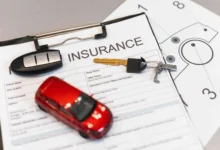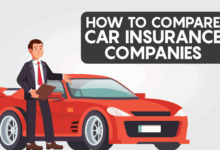Auto Insurance: A Comprehensive Guide
Auto insurance sets the stage for this exploration, offering a detailed look at various coverage types, premium factors, and the claims process. Understanding auto insurance is crucial for responsible driving and financial protection. This guide provides a comprehensive overview, empowering readers to make informed decisions about their coverage.
We will delve into the intricacies of liability, collision, and comprehensive coverage, comparing their benefits and limitations. We’ll also examine how factors like driving history, vehicle type, and location impact premiums, and offer strategies for securing the most affordable yet adequate coverage. The claims process, legal requirements, and common industry jargon will also be clarified.
Types of Auto Insurance Coverage
Choosing the right auto insurance coverage can feel overwhelming, but understanding the different types available is crucial for protecting yourself and your vehicle. This section will break down the most common types of coverage, highlighting their benefits and limitations to help you make informed decisions.
Liability Coverage
Liability coverage protects you financially if you cause an accident that injures someone or damages their property. It covers the costs of medical bills, lost wages, and property repairs for the other party involved. Liability coverage is typically expressed as three numbers, such as 25/50/25, representing the maximum amounts the insurance company will pay for bodily injury per person ($25,000), bodily injury per accident ($50,000), and property damage per accident ($25,000). It’s important to note that liability coverage only protects others; it does not cover your own medical bills or vehicle repairs.
Collision Coverage
Collision coverage pays for repairs or replacement of your vehicle if it’s damaged in an accident, regardless of who is at fault. This includes collisions with another vehicle, an object, or even a rollover. The insurance company will pay for the repairs up to the actual cash value (ACV) of your vehicle, minus your deductible. While collision coverage provides significant protection, it’s important to consider the cost of the premiums, especially for older vehicles where the repair costs might exceed the ACV.
Comprehensive Coverage
Comprehensive coverage protects your vehicle against damage caused by events other than collisions. This includes things like theft, vandalism, fire, hail, flood, and even damage from animals. Similar to collision coverage, the payout is typically based on the ACV of your vehicle, less your deductible. Comprehensive coverage offers peace of mind by protecting against a wider range of unforeseen circumstances.
Uninsured/Underinsured Motorist Coverage
Uninsured/underinsured motorist (UM/UIM) coverage protects you if you’re involved in an accident caused by a driver who is uninsured or underinsured. This coverage can pay for your medical bills, lost wages, and vehicle repairs, even if the other driver is at fault and lacks sufficient insurance. Given the prevalence of uninsured drivers, this coverage is highly recommended to ensure adequate protection.
Medical Payments Coverage
Medical payments (Med-Pay) coverage pays for medical expenses for you and your passengers, regardless of fault. This coverage can help cover medical bills, ambulance fees, and other related expenses resulting from an accident. Med-Pay coverage is often less expensive than other types of coverage and can be particularly beneficial in situations where injuries are minor.
| Coverage Type | Description | Benefits | Limitations |
|---|---|---|---|
| Liability | Covers injuries and damages you cause to others. | Protects you from financial ruin in an accident you cause. | Does not cover your own injuries or vehicle damage. |
| Collision | Covers damage to your vehicle in an accident, regardless of fault. | Repairs or replaces your damaged vehicle. | Requires a deductible; payout is based on ACV. |
| Comprehensive | Covers damage to your vehicle from non-collision events. | Protects against a wide range of risks, such as theft and weather damage. | Requires a deductible; payout is based on ACV. |
| Uninsured/Underinsured Motorist | Covers injuries and damages caused by an uninsured or underinsured driver. | Protects you even if the at-fault driver lacks sufficient coverage. | May have limitations on payout amounts. |
| Medical Payments | Covers medical expenses for you and your passengers, regardless of fault. | Helps cover medical bills after an accident. | Typically has a lower coverage limit than other types. |
Factors Affecting Auto Insurance Premiums
Understanding how insurance companies calculate your premiums is crucial for managing your auto insurance costs effectively. Several key factors are considered, each contributing to the final price you pay. These factors are interconnected and often influence each other, resulting in a personalized premium for every driver.
Several key elements influence the cost of your auto insurance. These include your age, driving history, the type of vehicle you drive, your location, and even your credit score.
Age
Insurance companies recognize that younger drivers statistically have higher accident rates than older, more experienced drivers. This increased risk translates to higher premiums for younger drivers. As drivers gain experience and reach a certain age (typically around 25), their premiums often decrease due to the perceived lower risk. For example, a 16-year-old driver will typically pay significantly more than a 35-year-old driver with a clean driving record, even if they drive the same car.
Driving Record
Your driving history is a significant factor. A clean driving record, free from accidents and traffic violations, indicates lower risk and will result in lower premiums. Conversely, accidents, speeding tickets, and DUI convictions significantly increase your premiums. The severity of the offenses will also impact the premium increase. Multiple violations will lead to substantially higher costs than a single minor infraction.
Vehicle Type
The type of vehicle you drive directly affects your insurance premium. Sports cars and high-performance vehicles are generally more expensive to insure due to their higher repair costs and increased risk of theft. Conversely, smaller, less expensive vehicles typically have lower insurance premiums. The vehicle’s safety features, such as anti-lock brakes and airbags, also influence the cost; vehicles with more safety features may receive lower premiums.
Location
Where you live plays a significant role in determining your insurance premiums. Areas with high crime rates, frequent accidents, or higher rates of vehicle theft will generally have higher insurance premiums. This is because insurance companies assess the risk of claims in different geographical locations. For example, urban areas often have higher premiums than rural areas due to increased traffic congestion and higher crime rates.
Credit Score
In many states, your credit score is a factor in determining your auto insurance premium. Insurers often view a good credit score as an indicator of responsible behavior, suggesting a lower risk of filing a claim. Conversely, a poor credit score may result in higher premiums. This is a controversial practice, but it’s legally permissible in many areas. It’s important to note that this is not necessarily a reflection of driving ability, but rather a broader assessment of financial responsibility.
Lowering Your Auto Insurance Premiums
Several strategies can help drivers lower their auto insurance premiums. These are not guaranteed to work for everyone, as the effectiveness depends on individual circumstances and insurance company policies.
- Maintain a clean driving record: Avoid accidents and traffic violations.
- Choose a safe vehicle: Select a car with good safety ratings and lower repair costs.
- Consider your coverage needs: Only purchase the coverage you need; avoid unnecessary extras.
- Bundle your insurance: Combine auto and home insurance policies for potential discounts.
- Shop around for insurance: Compare quotes from multiple insurance companies.
- Maintain a good credit score: A higher credit score can lead to lower premiums in many states.
- Take a defensive driving course: Completing a defensive driving course may qualify you for a discount.
- Increase your deductible: A higher deductible will lower your premium, but you will pay more out-of-pocket in case of a claim.
Choosing the Right Auto Insurance Policy
Selecting the right auto insurance policy is crucial for protecting yourself financially in the event of an accident or other unforeseen circumstances. The ideal policy balances adequate coverage with affordability, a delicate balance requiring careful consideration of your individual needs and risk profile. This process involves understanding your coverage options, comparing quotes, and making informed decisions based on your specific circumstances.
Choosing the appropriate coverage levels depends on several factors. Your driving history, the type of vehicle you own, your location, and your personal financial situation all play a role in determining the level of coverage that’s right for you. It’s also important to consider the potential consequences of an accident, including medical bills, vehicle repairs, and potential legal liabilities.
Assessing Individual Needs and Choosing Appropriate Coverage Levels
Understanding your personal risk tolerance and financial capacity is paramount. For example, someone with a high-risk driving record might opt for higher liability coverage to protect against significant legal costs in the event of an accident. Conversely, a driver with a clean record and a lower-value vehicle might choose a lower liability limit. Similarly, someone with limited financial resources might prioritize liability coverage over comprehensive or collision coverage, focusing on protection against potential lawsuits rather than vehicle damage. Careful consideration of these factors allows for a tailored insurance plan that provides the necessary protection without unnecessary expense.
Comparing Quotes from Multiple Insurers
Comparing quotes from several insurance providers is essential to finding the best value. Different insurers use different algorithms and rating factors, leading to variations in premiums for similar coverage levels. By obtaining multiple quotes, you can identify the insurer offering the most competitive rates for the level of coverage you require. This process can be streamlined using online comparison tools, but it’s important to carefully review the policy details of each quote to ensure that the coverage offered meets your needs. For example, one insurer might offer a lower premium but have higher deductibles, impacting your out-of-pocket expenses in the event of a claim.
A Step-by-Step Guide for Selecting an Auto Insurance Policy
A structured approach simplifies the process of selecting an auto insurance policy. First, determine your coverage needs based on your individual risk assessment and financial situation. Next, obtain quotes from multiple insurers, ensuring you compare apples to apples (meaning similar coverage levels). Third, carefully review the policy details of each quote, paying close attention to deductibles, premiums, and coverage limits. Fourth, choose the policy that best balances your need for coverage with your budget. Finally, review your policy periodically and adjust it as needed to reflect changes in your circumstances, such as a new vehicle or a change in your driving record. This proactive approach ensures that your auto insurance policy continues to provide adequate protection throughout your ownership of a vehicle.
Understanding Insurance Claims
Filing an auto insurance claim can seem daunting, but understanding the process can significantly ease the stress and ensure a smoother resolution. This section details the steps involved, the role of key players, and common claim scenarios. Accurate documentation is crucial throughout the entire process.
The Auto Insurance Claim Process
The process typically begins with reporting the accident to your insurance company as soon as possible. This usually involves contacting them by phone or through their online portal. You’ll need to provide details of the accident, including the date, time, location, and involved parties. Next, you’ll likely need to file a formal claim, often online or via mail, providing further details and supporting documentation such as police reports and photos of the damage. Your insurer will then assign a claims adjuster to investigate the accident.
The Role of the Insurance Adjuster
The insurance adjuster is a key figure in the claims process. Their role is to investigate the accident, assess the damages, and determine the extent of the insurance company’s liability. They will review all documentation provided, may interview witnesses, and potentially inspect the damaged vehicle. The adjuster’s assessment forms the basis of the insurance payout. It is vital to cooperate fully with the adjuster and provide accurate and complete information. Any discrepancies or omissions could delay or even jeopardize your claim.
Common Claim Scenarios and Resolutions
Several common scenarios arise in auto insurance claims. For example, a rear-end collision typically involves straightforward liability, with the at-fault driver’s insurance covering the damages to the other vehicle. However, in cases involving multiple vehicles or unclear liability, the investigation becomes more complex, potentially requiring witness statements and police reports to establish fault. Another scenario is a single-vehicle accident, such as hitting a deer or a tree. In such cases, comprehensive coverage is usually required to cover damages, as liability coverage typically doesn’t apply. Claims involving injuries are the most complex and may involve lengthy investigations, medical evaluations, and potentially legal proceedings. Resolutions vary greatly depending on the specifics of each case, ranging from a simple check payment for vehicle repairs to a complex settlement involving medical bills and lost wages. Accurate documentation, including photos of the damage, medical records, and repair estimates, is crucial in ensuring a fair and timely resolution.
Auto Insurance and Legal Requirements
Driving legally requires understanding and complying with your state’s auto insurance laws. These laws vary significantly across different jurisdictions, impacting both the minimum coverage requirements and the consequences of non-compliance. Failure to maintain the legally mandated insurance can lead to substantial fines and other penalties.
State-Specific Minimum Insurance Requirements
Each state establishes its own minimum requirements for auto insurance coverage. These typically involve a combination of bodily injury liability (covering injuries to others), property damage liability (covering damage to others’ property), and potentially uninsured/underinsured motorist coverage (protecting you if involved in an accident with an uninsured or underinsured driver). For example, some states may mandate minimum liability coverage of $25,000 per person and $50,000 per accident for bodily injury, while others may have higher or lower limits. It’s crucial to check your state’s Department of Motor Vehicles (DMV) website for precise details on these minimums. Failing to meet these minimums constitutes a violation of the law.
Penalties for Driving Without Insurance
The penalties for driving without auto insurance vary considerably by state but often include substantial fines, license suspension or revocation, vehicle impoundment, and even jail time in some cases. In addition to these direct penalties, driving without insurance can lead to significant financial hardship should you be involved in an accident. Without insurance, you would be personally responsible for covering all costs associated with damages and injuries, potentially leading to substantial debt or bankruptcy. Furthermore, your ability to obtain insurance in the future may be negatively impacted, leading to higher premiums.
Proving Insurance Coverage to Authorities
Proof of insurance is typically required to register a vehicle and maintain a valid driver’s license. This proof usually takes the form of an insurance identification card issued by your insurance company. Law enforcement officers may request to see this card during traffic stops. Failure to present valid proof of insurance can result in immediate penalties. In some states, electronic proof of insurance is also accepted, where your insurance information is electronically verified through a state database. Maintaining readily accessible proof of insurance is vital to avoid legal complications and potential penalties.
Common Auto Insurance Jargon
Navigating the world of auto insurance can feel overwhelming, largely due to the specialized vocabulary used by insurance companies. Understanding these terms is crucial for making informed decisions about your coverage. This section provides a glossary of common auto insurance terms to help demystify the process.
Glossary of Common Auto Insurance Terms
Understanding the terminology is key to selecting the right policy and filing claims effectively. The following definitions explain some of the most frequently encountered terms.
Deductible: This is the amount of money you pay out-of-pocket before your insurance coverage kicks in. For example, if you have a $500 deductible and your car repair costs $2,000, you pay $500, and your insurance company pays the remaining $1,500.
Premium: This is the regular payment you make to your insurance company to maintain your auto insurance coverage. Premiums are calculated based on several factors, including your driving history, the type of car you drive, and your location. Think of it as the price you pay for the protection your policy provides.
Liability Limits: These are the maximum amounts your insurance company will pay for damages caused by an accident you are at fault for. Liability limits are usually expressed as three numbers, such as 25/50/25. This means your insurance will pay up to $25,000 for injuries to one person, $50,000 for injuries to multiple people in a single accident, and $25,000 for property damage.
UM/UIM Coverage (Uninsured/Underinsured Motorist Coverage): This coverage protects you if you’re involved in an accident caused by an uninsured or underinsured driver. UM coverage protects you if the at-fault driver has no insurance, while UIM coverage protects you if the at-fault driver’s insurance limits are insufficient to cover your damages. For example, if an uninsured driver causes an accident resulting in $30,000 in medical bills, your UM coverage would help cover the costs, up to your policy limits.
Comprehensive Coverage: This type of coverage protects your vehicle against damage from events other than collisions, such as theft, vandalism, fire, or hail damage. It’s optional but provides broader protection.
Collision Coverage: This coverage pays for repairs or replacement of your vehicle if it’s damaged in a collision, regardless of who is at fault. This is also optional, but highly recommended.
Illustrative Scenario: Accident & Claim Process
This scenario details a typical car accident and the subsequent insurance claim process. Understanding these steps can help you navigate a stressful situation more effectively. Remember, every accident is unique, and specific procedures may vary depending on your location and insurance provider.
Accident Details
On a rainy Tuesday afternoon, Sarah, driving a 2018 Honda Civic, was stopped at a red light. John, driving a 2020 Ford F-150, was following too closely and failed to brake in time, rear-ending Sarah’s vehicle. The impact caused significant damage to the rear of Sarah’s Civic, including a crushed bumper and damaged taillights. John’s truck sustained minor damage to its front bumper. A witness, Mr. Lee, observed the accident and noted John’s speed and the poor visibility due to the rain. Mr. Lee provided his contact information to both drivers.
Immediate Actions After the Accident
Following the collision, both Sarah and John immediately checked for injuries. Fortunately, neither driver nor Mr. Lee sustained any injuries. They then moved their vehicles to the side of the road to avoid obstructing traffic. Sarah and John exchanged information: driver’s licenses, insurance details, contact information, and vehicle registration details. They also documented the accident scene by taking photographs of the damage to both vehicles, the surrounding area, and any visible skid marks. Mr. Lee’s statement was recorded, including his contact information. The police were called to the scene to file an accident report. This report included details of the accident, witness statements, and a diagram of the accident scene.
Filing an Insurance Claim
Sarah contacted her insurance company, reporting the accident and providing all the collected information: the police report number, photographs of the damage, witness statements, and the other driver’s insurance details. Her insurance company assigned a claims adjuster to handle her case. The adjuster reviewed the information provided, including the police report, photographs, and witness statements. They contacted John’s insurance company to initiate a discussion on liability. John’s insurance company also conducted their own investigation, including reviewing the police report and obtaining statements from involved parties.
Claim Assessment and Settlement
After reviewing all evidence, Sarah’s insurance company determined that John was at fault due to following too closely. John’s insurance company agreed. Sarah’s insurance company covered the repairs to her vehicle under her collision coverage. The cost of repairs was estimated at $4,500. Sarah’s insurance company then negotiated with the repair shop to ensure the repairs were completed efficiently and at a fair price. Once the repairs were completed, Sarah’s insurance company reimbursed her for the repair costs. Because John was at fault, his insurance company may pursue a subrogation claim against John for the costs incurred by Sarah’s insurance company.
Final Thoughts
Navigating the world of auto insurance can seem daunting, but with a clear understanding of coverage options, premium influencers, and the claims process, drivers can make informed choices to protect themselves and their vehicles. By comparing quotes, understanding legal requirements, and proactively managing risk, individuals can secure the most suitable and cost-effective auto insurance policy. Remember, proper insurance is not just a legal obligation, but a crucial component of responsible driving.




